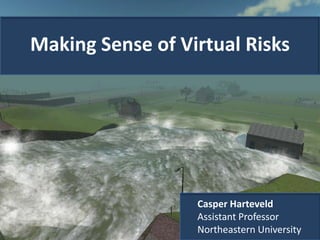Making Sense of Virtual Risks
- 1. Making Sense of Virtual Risks Casper Harteveld Assistant Professor Northeastern University
- 3. Casper about 8 years old Casper (expected) about 35 years old
- 4. 2006
- 8. Proof
- 10. âĶalso a unique opportunity!
- 11. Approach 1: Factors and Effectiveness Approach 2: Experience and Game Data INPUT OUTPUT
- 16. BLAH BLAH BLAH BLAH BLAH BLAH BLAH BLAH Effectiveness
- 17. Factors Age Education Computer skills Game Score # Exercises
- 18. Game data No clear learning process Consistency
- 20. Long Road Ahead Casper Harteveld c.harteveld@neu.edu
- 21. TschÞÃ! Greetings from Boston! Casper Harteveld c.harteveld@neu.edu northeastern.edu/casperharteveld
Editor's Notes
- Hello! My name is Casper Harteveld and I wrote a dissertation called Making Sense of Virtual Risks. I am honored to receive the German Simulation & Gaming Award for this work.
- A little bit about me. When I was about eight years I played a lot of games. A LOT! In fact, people expected that when I would turn 35 I wouldâĶ..
- Look something like this. I still have some years to go but in the mean time I met people at Delft University of Technology who have been investigating the use of games for serious purposes. I was very interested in what they did and so it happenedâĶ
- That in 2006 I started working together with a team at a research institute called Deltares in developing a very unique game.
- The game was developed to train levee patrollers. The Netherlands is country below sea level and has many levees that protect the land from flooding. Levee patrollers are people who walk over the levee to inspect their condition and see if something is wrong. The only problem is: How do these people know what to look for? Failures occur rarely and so they cannot practice in reality. People thought a game might be a solution.
- This is what we created. The game was called levee patroller. In this game players have to find virtual failures in a 3D virtual environment and make sense of them. If they donât do this in time, a flooding might occur.
- This is a unique game but in the past decennium many serious games have been developed â for different purposes and in different domains. .
- The basic question among all these games is whether they work â and what makes them work.
- Levee patroller might be a unique game but other than that many similar games exist that are also about making sense of virtual risksâĶ.
- It also provided for a unique opportunity for an in-depth study. Unlike other games the game was not a prototype but fully developed. It was ready to be implemented. As the designer I also had complete knowledge of the game and access to various important resources.
- In the study I used two approaches. With the first approach I looked at whether the game was doing what it was supposed to do â its effectiveness. I also wanted to know what contributed to this. The second approach was about opening the black box of playing the game. I looked at how participants experienced playing the game and what they did in the game. So what choices they made, how they walked, and so on.
- I sent an invitation to three different organizations and intotal 147 participants participated.
- I set up my own training at these organizations that involved a startmeeting and endmeeting where participants came together such as in the picture. In between the players played at home. The training took 3 weeks.
- It was a tough crowd. The average age was 48, they had little computer skills, and few played computer games, if at all. Some even didnât own a computer!
- Despite this tough crowd 80% played nearly all exercises, spending 12 to 20 hours on the training. This completely exceeded all of our expectations and highlights the engaging power of games.
- Other results indicate that the participants became more accurate in making sense of failures. They also did this with fewer words. No difference could be observed in how participants made sense of virtual versus real pictures, showing that transfer happened. Before the training experts performed better than the participants but after the training participants performed just as good as the experts. All of this shows that the game is effective.
- A complex network of factors contributed to this effectiveness, such as age and computer skills. A crucial factor turned out to be how well they played the game. This tells us that it is incredibly important of what is happening inside a game. It also tells us that game performance can be used as an assessment tool.
- However, when considering the game data no clear learning process can be seen. Participants remained very consistent in the choices they made. This tells us that the glass might be half full and that with better feedback the gains could be even greater.
- From how participants experienced the game we see an incredible diversity based on their background and possibly personality. This tells us that in developing a game we have to consider this diversity. It becomes clear that it is a sensitive medium. Little errors in the game caused the greatest frustrations. This tells us that great care and attention to detail is needed in developing games.
- All these results showcase the great potential that games have. However, we still have a long road ahead of us. Most certainly when it comes to implementation. Many obstacles exist and despite the great results of levee patroller, this game is still not structurally implemented. I encourage anyone to continue this work as I continued the work of many others.
- Greetings from Boston. And Tschuss!!!





















